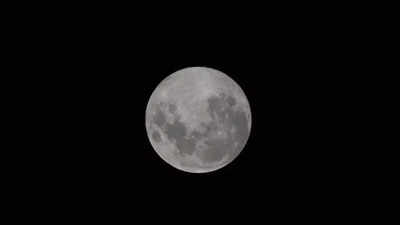- News
- Science News
- NASA to establish New Lunar Time Standard with Coordinated Lunar Time (LTC) initiative
NASA to establish New Lunar Time Standard with Coordinated Lunar Time (LTC) initiative
NASA is working on establishing Coordinated Lunar Time (LTC) following a directive from the White House. This effort aims to create a standardized time system for the Moon, which will be crucial for future lunar missions and could be applied to other celestial bodies. The project is led by NASA’s Space Communication and Navigation program.

Image sources: NASA
A groundbreaking project is set to establish Coordinated Lunar Time (LTC) by NASA following a White House directive issued in April. This initiative, led by NASA’s Space Communication and Navigation (SCaN) program, aims to create a standardised time system for the Moon, which will be essential for the planned lunar ecosystem and could potentially be applied to other celestial bodies in the solar system.
The need for a Lunar Time Standard
The concept of LTC involves using a weighted average of atomic clocks positioned on the Moon to determine time, similar to how Earth's Coordinated Universal Time (UTC) is established.
Challenges in determining Lunar Time
Impact on future Lunar missions
As NASA’s Artemis campaign aims to establish a sustained presence on the Moon, having a reliable lunar time standard will be crucial for the safety and efficiency of future missions. The LTC system is also expected to be scalable for use on Mars and other celestial bodies, facilitating long-duration exploration beyond the Moon.
The role of NASA’s SCaN program
NASA’s SCaN program, responsible for space communications and navigation, is at the forefront of implementing this lunar time standard. The program supports over 100 missions through its Near Space Network and Deep Space Network, highlighting its critical role in space exploration.
Global implications and future prospects
As commercial space activities and international participation in lunar exploration expand, the need for standardised time systems becomes increasingly important. Dr. Ben Ashman, navigation lead for lunar relay development at NASA, emphasises that a shared time standard will enhance safety, resilience, and sustainability in space operations.
The development of Coordinated Lunar Time represents a significant advancement in space exploration, ensuring accurate timing and positioning for future missions. This initiative not only addresses current challenges but also lays the groundwork for the exploration of Mars and beyond, marking a crucial step in humanity’s journey into space.
Also Read | Polaris Dawn mission: Two women astronauts surpass Gemini 11’s 1966 record with 1,400-kilometre flight
The need for a Lunar Time Standard
The concept of LTC involves using a weighted average of atomic clocks positioned on the Moon to determine time, similar to how Earth's Coordinated Universal Time (UTC) is established.
However, determining the exact locations for these clocks poses a challenge. Current analyses suggest that atomic clocks on the Moon’s surface may tick faster by microseconds per day compared to Earth’s clocks.
Challenges in determining Lunar Time
According to NASA, researchers are currently investigating mathematical models that will be best suited for establishing accurate lunar time. For perspective, a difference of 56 microseconds, while seemingly minute, can translate into significant positional discrepancies. Cheryl Gramling, NASA’s lead on lunar position, navigation, timing, and standards, explains that a time discrepancy of 56 microseconds is equivalent to travelling the distance of approximately 168 football fields at the speed of light. This could result in substantial errors in positioning if not properly addressed.
Impact on future Lunar missions
As NASA’s Artemis campaign aims to establish a sustained presence on the Moon, having a reliable lunar time standard will be crucial for the safety and efficiency of future missions. The LTC system is also expected to be scalable for use on Mars and other celestial bodies, facilitating long-duration exploration beyond the Moon.
The role of NASA’s SCaN program
NASA’s SCaN program, responsible for space communications and navigation, is at the forefront of implementing this lunar time standard. The program supports over 100 missions through its Near Space Network and Deep Space Network, highlighting its critical role in space exploration.
Global implications and future prospects
As commercial space activities and international participation in lunar exploration expand, the need for standardised time systems becomes increasingly important. Dr. Ben Ashman, navigation lead for lunar relay development at NASA, emphasises that a shared time standard will enhance safety, resilience, and sustainability in space operations.
The development of Coordinated Lunar Time represents a significant advancement in space exploration, ensuring accurate timing and positioning for future missions. This initiative not only addresses current challenges but also lays the groundwork for the exploration of Mars and beyond, marking a crucial step in humanity’s journey into space.
Also Read | Polaris Dawn mission: Two women astronauts surpass Gemini 11’s 1966 record with 1,400-kilometre flight
End of Article
FOLLOW US ON SOCIAL MEDIA

